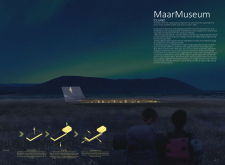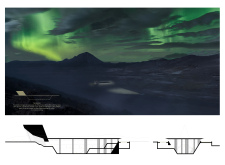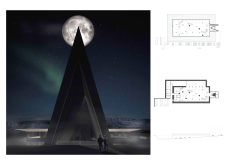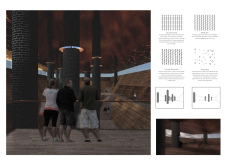5 key facts about this project
From a functional perspective, the Maar Museum serves as a venue for artistic exhibitions, educational programs, and community activities, enriching the local cultural scene. The design of the museum allows it to function not only as a display space for art but also as an immersive experience that encourages visitors to explore the narrative of Iceland's unique geology. The layout prioritizes visitor circulation and accessibility, guiding individuals through a series of interconnected spaces that provide varying perspectives of the surrounding landscape.
The architectural design showcases several important elements that contribute to its overall vision. This project features a central exhibition hall, characterized by expansive glass panels that invite natural light while framing views of the stunning landscapes outside. The play of light throughout the space enhances the experience of the artwork displayed while simultaneously connecting visitors to the exterior environment. This transparency reinforces the concept of the museum as an extension of the landscape, allowing the natural world to be a part of the artistic experience.
In addition to the exhibition hall, the Maar Museum incorporates various functional spaces such as classrooms, workshops, and gathering areas that are essential for educational programs and community interaction. The layout is designed to adapt to various events, from art installations to public lectures, making it a versatile venue for different activities. The interior design uses materials such as concrete, clay brick, and wood to create a warm and welcoming atmosphere that respects the traditional construction methods found in Iceland.
The unique design approach of the Maar Museum lies in its inspiration drawn directly from the geological features of the site. The architecture employs angular forms and layered structures that evoke the volcanic activity and geological shifts typical of the region, creating a sense of harmony between the manmade and the natural. This approach not only enhances the aesthetic qualities of the building but also serves to educate visitors about the geological processes that have shaped Iceland over millions of years.
Sustainable practices are evident in the design of the museum, utilizing local materials that reduce environmental impact while also fostering a sense of place. The use of renewable resources and thoughtful orientation of the building maximizes energy efficiency and minimizes the carbon footprint. This commitment to sustainability reflects contemporary architectural principles that prioritize environmental stewardship alongside cultural and aesthetic values.
Further enhancing the engagement with the landscape, features such as carefully positioned viewing platforms allow visitors to connect with the northern lights, providing unique experiences that tie the interior space with the extraordinary phenomena outside. This ties back to the project’s overarching aim to create a venue that is not only a repository of art but also a focal point for experiencing the remarkable Icelandic landscape.
The Maar Museum stands as a profound example of how architecture can reflect and respect its geographic context while serving diverse community functions. The balance of form, function, and sustainability within the design articulates a clear architectural vision grounded in the site's natural features. For those interested in a deeper exploration of the architectural plans, sections, designs, and ideas, the presentation of the project offers an opportunity to gain further insights into its thoughtful execution and concept. Engaging with these elements will provide a more comprehensive understanding of this significant architectural endeavor.


























